Religion: Religious Leaders Pre-1900
Martin of Tours (316/336-397)
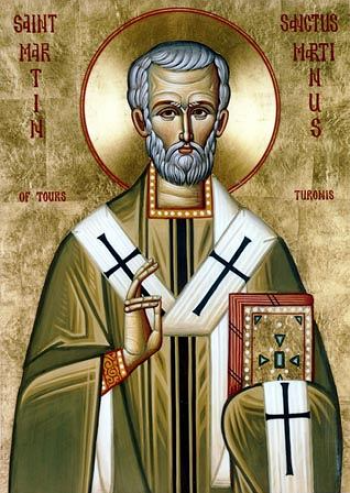
Religion and Branch: Christianity (Catholicism)
Title: Saint, Bishop of Tours
Martin of Tours is one of the most well-known saints in the history of the Christian Church, particularly in France. Born in what is now Szombathely, Hungary, he grew up in Pavia, Italy, and initially served in the Roman army but left it after experiencing a vision that solidified his commitment to Christianity.
Martin was reluctantly made bishop of Tours in 371. Despite his new role, he emphasized a monastic lifestyle, living simply and aiding the poor. Recognized as a pioneer of Western monasticism, he established the Marmoutier Monastery near Tours, which became a significant center for monasticism in Europe.
Martin is best known for his missionary work in the rural areas of Gaul (modern-day France). He actively evangelized the countryside, confronting pagan practices and establishing Christian communities.
Numerous miracles and legends are associated with Saint Martin. One of the most famous stories recounts him cutting his cloak in half to share with a freezing beggar, only to dream of Jesus Christ wearing the half-cloak that night, highlighting Christian charity.
After his death, Martin was quickly venerated as a saint, and his shrine in Tours became a major pilgrimage site in the Middle Ages. The "St. Martin's Lent" (a period of fasting leading up to Christmas) and the celebration of Martinmas (St. Martin's Day) on November 11 were observed in his honor.
Over the centuries, countless churches, chapels, and religious institutions in France have been dedicated to St. Martin. He had a profound impact on the development of Christian faith and practices in France, making him one of the country's most venerated religious figures. His legacy as a bishop, monastic founder, and evangelizer made him an enduring figure in French religious history.
Genevieve (circa 419/422 to circa 502/512)
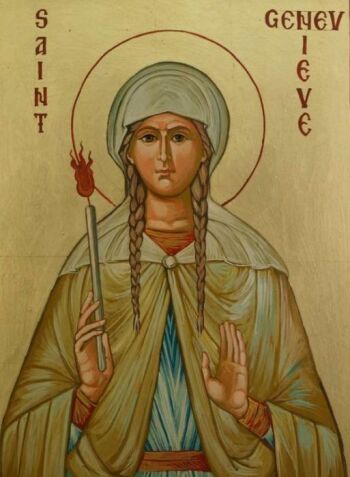
Religion and Branch: Christianity (Catholicism)
Title: Saint
Genevieve is a significant figure in the religious history of France, particularly associated with the city of Paris. Born in Nanterre, a small town near Paris, she displayed signs of piety from a young age. It's said that when Saint Germanus of Auxerre visited Nanterre, he noticed her devotion and predicted she would lead a life of sanctity.
At a young age, Genevieve consecrated herself to God and took a vow of virginity. She later moved to Paris, where she led a life of prayer, fasting, and charity.
One of the most famous legends associated with Saint Genevieve is her intercession to prevent the invasion of Paris by Attila the Hun and his army in 451. Through her prayers and encouragement to the citizens of Paris to pray and fast, Attila's course was diverted away from Paris.
Throughout her life, Genevieve was known for performing miracles, including turning water into wine during a shortage and stopping a fire in Paris with her prayers. After her death, she was venerated as a saint. Her relics were kept in the church of Saint Genevieve, which later became the Panthéon in Paris, a mausoleum containing the remains of distinguished French citizens.
Saint Genevieve is the patron saint of Paris, and her intercessions were often invoked during various crises in the city's history. Her feast day is celebrated on January 3. She holds a special place in the hearts of the Parisian people and remains a symbol of faith and resilience in the face of adversity for the French.
Rashi (1040-1105)
Religion and Branch: Judaism
Title: Rabbi, Scholar, Commentator
Rashi, whose full name was Shlomo Yitzchaki, was a medieval French rabbi and one of the most prominent Jewish commentators on the Hebrew Bible and Talmud. His influence on Jewish scholarship and religious life, not only in France but worldwide, is immense.
Born in Troyes, in the Champagne region of northern France, he lived and studied in the country for most of his life. His teachings were deeply influenced by the Jewish communities of the Rhineland and northern France. He established a yeshiva (Jewish religious school) in Troyes, which attracted numerous students. His school became a leading center of Jewish learning in Europe.
Rashi's commentaries on the Hebrew Bible and Talmud are renowned for their clarity and insight. They have been studied by Jewish scholars and laypeople alike for centuries. His explanations, often based on the literal meaning of the text, made these foundational Jewish texts more accessible to a broader audience. His commentaries became so fundamental that they were incorporated into the margins of both the Talmud and the Hebrew Bible in printed editions, ensuring their widespread dissemination and study.
Rashi's work offers insights into the life, practices, and challenges faced by the Jewish communities in medieval France. His commentaries occasionally provide glimpses of local customs, practices, and societal conditions.
Rashi was a pivotal figure in Jewish scholarship and religious life in medieval France. His commentaries remain foundational texts in Jewish study to this day.
William of Champeaux (circa 1070-1121)
Religion and Branch: Christianity (Catholicism)
Title: Bishop of Châlons, Philosopher, Theologian, Founder of Abbey of Saint-Victor
William of Champeaux was an influential medieval philosopher and theologian in France during the 11th and 12th centuries.
William was a leading teacher in Paris, where he ran a school near the Cathedral of Notre Dame. His school was one of the predecessors to the University of Paris, and he played a significant role in the intellectual scene of the city.
Philosophically, William is best remembered for his views on universals. Initially, he was a proponent of a form of extreme realism, arguing that universals had a real existence outside the mind. However, over time, his views evolved, moving away from extreme positions.
One of his most famous students was Peter Abelard, who would later become his intellectual rival. Abelard, a nominalist, challenged William's teachings on universals, leading to significant philosophical debates that shaped scholastic thought.
William had a successful ecclesiastical career. He was appointed bishop of Châlons in 1113, a position he held until his death.
William's contributions to philosophy laid the groundwork for later scholastic thought. Though his views on universals were eventually overshadowed by those of his more famous student, Abelard, and other thinkers such as Thomas Aquinas, his influence as a teacher and thinker was profound during his lifetime. William of Champeaux was a pivotal figure in the early scholastic period of France, contributing to philosophical debates and establishing a foundation for the growth of intellectual inquiry in Paris.
Hugues de Payens (1070-1136)
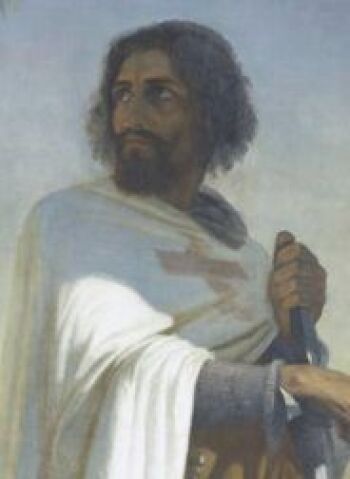
Religion and Branch: Christianity (Catholicism)
Title: Cofounder and First Grand Master of Knights Templar
Hugues de Payens was a French knight and one of the founding figures of the Knights Templar, a medieval Christian military order.
After the First Crusade successfully captured Jerusalem in 1099, Christian pilgrims began to journey to the Holy Land. However, many faced attacks during their pilgrimage. Around 1119, Payens and eight other knights formed a brotherhood in arms to protect these pilgrims, giving birth to what would become the Knights Templar.
Hugues and his fellow knights took monastic vows and were recognized as a religious order at the Council of Troyes in 1129. The Templars were endorsed and supported by the church, with Bernard of Clairvaux, a key religious figure in France, writing a rule of order for them and championing their cause.
Under Payens' leadership as the grand master, the Knights Templar grew rapidly in membership and wealth. They established a network of fortifications across the Holy Land and became heavily involved in banking and financial operations in Europe.
Although Payens led the Templars for only 20 years, his impact was significant. The order continued to grow after his death, becoming one of the most powerful and wealthy organizations in the Christian world. However, their influence eventually waned, and by the early 14th century, the order faced suppression by both the church and the French monarchy.
Payens is notable for his role in founding and shaping the Knights Templar, an organization that melded religious and military aspirations and played a pivotal role in the religious and political dynamics of medieval Europe and the Holy Land.
Bernard of Clairvaux (1090-1153)

Religion and Branch: Christianity (Catholicism)
Title: Saint, Abbot, Mystic, Theologian, Doctor of the Church
Bernard of Clairvaux was a pivotal figure in the religious landscape of medieval France and had a profound influence on the wider Christian world during the 12th century.
Bernard joined the Cistercian order, a monastic reform movement, in his early 20s and became a monk at the Abbey of Cîteaux. Inspired by the order's dedication to austerity, prayer, and manual labor, he later founded the Abbey of Clairvaux in 1115, which rapidly grew in size and influence under his leadership.
As a theologian, Bernard was known for his passionate sermons and significant theological treatises. His writings emphasized the importance of a deep, personal relationship with Christ, particularly through devotion to the Virgin Mary.
Bernard's counsel was sought by popes, kings, and other influential figures of his time. He played a central role in the election and endorsement of Pope Innocent II during a papal schism. Bernard actively combated heresies, most notably against Peter Abelard, a leading philosopher and theologian of the time. Bernard challenged some of Abelard's teachings, leading to the latter's works being condemned at the Council of Sens in 1141.
One of Bernard's most controversial roles was his fervent preaching in favor of the Second Crusade. His charismatic sermons played a significant part in rallying European leaders and knights to participate, although the crusade itself ended in failure.
Bernard of Clairvaux's impact on the religious culture of France and the broader Christian world of the Middle Ages was profound. His spiritual teachings, combined with his active role in ecclesiastical and secular affairs, make him one of the most influential religious figures of the 12th century.
Bernard's spiritual writings and hymns have endured, making him a central figure in Western Christian mysticism. He was canonized in 1174 and later declared a Doctor of the Church in recognition of his theological contributions.
Jacob ben Meir (1100-1171)
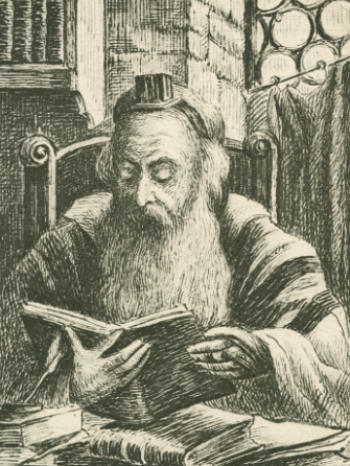
Religion and Branch: Judaism
Title: Rabbi, Tosafist
Jacob ben Meir, best known as Rabbi Tam, was one of the most prominent Ashkenazi rabbis and Talmudic scholars of the 12th century. He was a pivotal figure in the development of Jewish law and thought during the Middle Ages.
Born in the Champagne region of France, Meir came from an illustrious rabbinic family. He was the grandson of Rashi (Rabbi Shlomo Yitzchaki), one of the most revered commentators on the Torah and Talmud.
Meir was a leading Talmudist of his time. His interpretations and legal decisions were widely recognized and continue to be influential in Halakhic (Jewish legal) discussions. His Talmudic novellae are studied and cited to this day.
One of Meir's significant contributions to Jewish literature is Book of the Upright. This work consists of novellae on the Talmud, responsa, and various halakhic discussions.
Meir is perhaps best known as the foremost figure among the Tosafists. They were medieval Talmudic scholars, primarily from France and Germany, who wrote critical and explanatory glosses (known as Tosafot) on the Talmud, expanding upon Rashi's commentary. These glosses often delved into intricate legal discussions and addressed apparent contradictions in the Talmud.
Meir is famously known for his dispute regarding the order of the tefillin (phylacteries) passages. While the mainstream tradition follows the order presented by Rashi (his grandfather), Meir proposed a different sequence based on his understanding of various Talmudic sources.
In 1146, during the Second Crusade, Meir and his community faced violent persecutions. He himself was reportedly wounded but survived. These traumatic events did not deter him; he continued his scholarly activities and rebuilding Jewish communities.
Meir's impact on Jewish law and thought is profound. His legal decisions, interpretations, and methodologies greatly influenced subsequent generations of rabbis and scholars. His approach, blending rigorous textual analysis with a deep understanding of the lived realities of Jewish communities, set a standard for rabbinic scholarship.
Meir was a towering figure in medieval Ashkenazi Judaism. His scholarship, legal decisions, and leadership left an indelible mark on the trajectory of Jewish thought and practice.
Isaac ben Samuel (circa 1115 to circa 1184)
Religion and Branch: Judaism
Title: Rabbi, Tosafist
Isaac ben Samuel, often referred to as the Ri (an abbreviation derived from Rabbi Isaac), was a prominent French Talmudist and one of the leading Tosafists of his time. Tosafists were medieval Talmudic scholars in France and Germany who are particularly known for their tosafot—critical and explanatory glosses on the Talmud, which add to the commentary of Rashi, a major medieval commentator on the Talmud.
Samuel was a student of the esteemed Talmudic scholar, Rabbi Tam (Jacob ben Meir), who was a grandson of Rashi. He was also influenced by other leading Jewish scholars of the time.
The Tosafists' work, including that of the Ri, is characterized by an analytical approach to Talmudic study, often addressing apparent contradictions in the text and resolving them through various means. Isaac ben Samuel's contributions to the tosafot are found in many tractates of the Talmud, reflecting his keen analytical mind and deep scholarship.
Samuel was not only a scholar but also a leader in the Jewish community. He headed yeshivot (Talmudic academies) in Dampierre, a major center of Jewish learning in France during the medieval period. Through his leadership roles, he helped shape the direction of Jewish thought and practice in Ashkenazi communities.
Apart from his work on the tosafot, Samuel issued numerous halachic (Jewish legal) decisions, many of which have been incorporated into the standard codes of Jewish law. His rulings often reflect a balance between strict interpretation of the law and sensitivity to practical concerns and the realities of Jewish communal life.
Samuel's contributions to Talmudic scholarship and Jewish law have left an enduring impact. His teachings, as well as those of other Tosafists, have been studied by generations of Talmudic scholars and continue to be integral to advanced Talmudic study today.
Samuel was a central figure in Ashkenazi Jewish scholarship during the Middle Ages. His contributions as a Tosafist and as a halachic authority solidified his reputation as one of the great Jewish scholars of his era, and his work continues to influence Jewish thought and practice.
Baruch ben Isaac (circa 1140-1212)
Religion and Branch: Judaism
Title: Rabbi, Scholar
Baruch ben Isaac is best known in the context of Ashkenazi Judaism as a medieval rabbi and scholar from the region of what is now Germany. His most renowned work is his Book of the Heave Offering, which is a significant halakhic (Jewish legal) work.
Book of the Heave Offering is divided into sections and covers various topics related to Jewish law. Isaac addresses several ritual practices, laws of Sabbath and festivals, dietary laws, and more. The book is known for its systematic organization and is notable for citing and reconciling various earlier sources. In addition to his major work, he wrote responsa and provided commentary on various Talmudic topics, further establishing his position as a leading scholar of his time.
Rabbi Isaac was an important figure in the medieval Ashkenazi rabbinic tradition. The Ashkenazim, primarily Jews of France and Germany during this period, had a distinct set of customs, liturgical practices, and halakhic interpretations. His writings influenced later Ashkenazi rabbis and halakhic decisions. His ability to harmonize various opinions and provide clear rulings was particularly valued.
Isaac lived during a dynamic period of Jewish scholarship in Ashkenaz. This era witnessed the rise of Tosafists, who were medieval Talmudic scholars from France and Germany known for their critical discussions and additions (Tosafot) to Rashi's commentary on the Talmud. Though it's not clear if Isaac was directly linked to the Tosafist school, he lived in an environment of intense Talmudic scholarship.
Rabbi Isaac's contributions to the realm of Ashkenazi halakhic literature have left a lasting legacy. His works continue to be studied and are referenced in later halakhic discussions.
Louis IX (1214-1270)
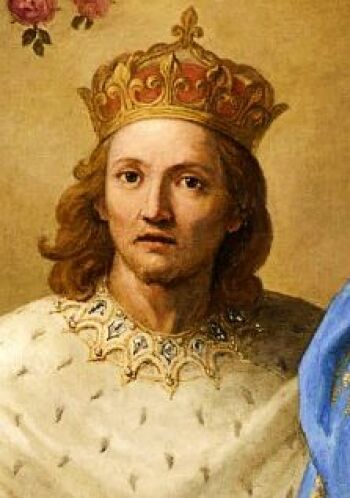
Religion and Branch: Christianity (Catholicism)
Title: King of France, Saint
Louis IX, commonly known as Saint Louis, was King of France from 1226 to 1270 and is one of the most famous Catholic monarchs in French history. Known for his profound personal piety, he frequently attended mass, prayed regularly, fasted, and was devoted to the Virgin Mary. His personal life was marked by ascetic practices, and he was deeply influenced by the teachings of the Catholic Church.
Louis's religious fervor also led to stricter policies against non-Christians. He imposed heavy fines on Jews for not wearing identifying badges, confiscated Jewish property, and in 1240, ordered the public disputation of the Talmud, which eventually led to its public burning in Paris in 1242.
Motivated by religious zeal, Louis led the Seventh Crusade (1248-1254) against the Muslims in Egypt. The crusade was initially successful but ended in failure when Louis was captured and later ransomed. Despite the setback, Louis embarked on another crusade in 1270, targeting Tunis. However, the campaign was short-lived as Louis died of dysentery shortly after landing.
One of Louis's most enduring legacies is the Sainte-Chapelle in Paris, a Gothic chapel he commissioned to house Christian relics, including what was believed to be the Crown of Thorns. The chapel stands as a testament to Louis' deep devotion and his desire to make Paris a religious center.
Louis was also known for his sense of justice and charity. He reformed the French judicial system, introducing the appel comme d'abus, a form of judicial review. He also supported charitable works, establishing several hospitals and caring for the poor and sick.
Louis significantly shaped the religious landscape of medieval France through his fervent Catholicism, participation in the Crusades, and various reforms and constructions that underscored the intertwining of his royal and religious duties. Due to his exemplary piety and contributions to the Catholic Church, Louis IX was canonized by Pope Boniface VIII in 1297, making him the only French monarch to be declared a saint.
Martin Bucer (1491-1551)
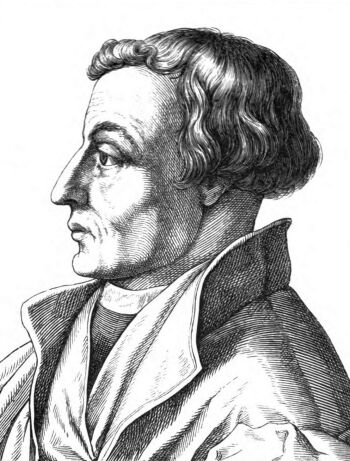
Religion and Branch: Protestant Christianity (Reformed)
Title: Preacher, Reformer
Martin Bucer (or Butzer) was an important Protestant reformer of the 16th century who played a significant role in the early days of the Protestant Reformation, particularly in the regions of Strasbourg and the Holy Roman Empire. His influence extended to both the Lutheran and Reformed traditions, and he sought unity among Protestant factions.
Born in the Electorate of the Palatinate in what is now Germany, Bucer initially joined the Dominican Order. After studying at Heidelberg, he came into contact with humanist thought and the writings of Erasmus, which would influence his later theological perspectives.
Bucer was deeply influenced by Martin Luther, particularly after meeting him at the Heidelberg Disputation in 1518. By the 1520s, Bucer had left the Dominican Order, and he was excommunicated from the Catholic Church for his Lutheran beliefs.
Bucer became a key figure in establishing Protestantism in Strasbourg. In the city, he worked on creating a reformed church liturgy, implemented evangelical reforms, and sought to establish a middle ground between the theological positions of Luther and Zwingli.
One of Bucer's significant contributions was his attempt to reconcile differing Protestant views on the Eucharist (or Lord's Supper). While he personally held views closer to Zwingli's symbolic understanding of the Eucharist, Bucer worked hard to find a theological compromise between Lutherans and Zwinglians. His efforts culminated in the Wittenberg Concord (1536), which, while achieving temporary agreement, couldn't permanently bridge the divide.
John Calvin, during his initial exile from Geneva, settled in Strasbourg and came under the mentorship of Bucer. The two reformers had a close relationship, and Bucer's influence can be seen in some aspects of Calvin's theology.
Facing religious pressures in the Holy Roman Empire due to the Augsburg Interim, Bucer moved to England in 1549. He became Regius Professor of Divinity at the University of Cambridge. During his time in England, Bucer influenced the English Reformation, especially the liturgy of the Church of England, through his criticisms of the Book of Common Prayer.
Throughout his life, Bucer had a passion for achieving unity among the various Protestant groups. He engaged in numerous colloquies and dialogues to bridge theological divides, not only among Protestants but also between Protestants and Catholics.
After his death in 1551, Bucer's influence continued, especially in the Palatinate, where his moderate approach to the Reformation shaped the region's religious policies. He also had a lasting impact on Calvinism and the English Reformation.
Bucer was a pivotal figure in the early Protestant Reformation, with a unique role as a mediator between various theological perspectives. His efforts at unity, reformation in Strasbourg, and influence on other major reformers such as Calvin make him one of the central figures of 16th-century Protestantism.
John Calvin (1509-1564)
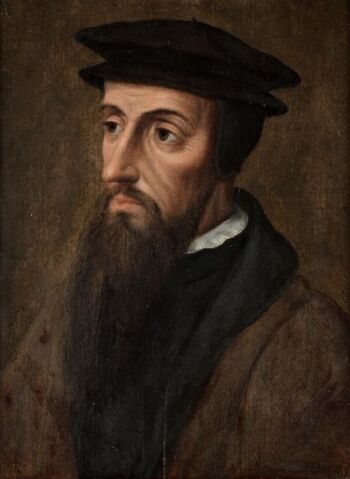
Religion and Branch: Protestant Christianity (Reformed)
Title: Theologian, Pastor, Reformer
John Calvin was a pivotal figure in the Protestant Reformation and is best known for his role in developing the theological system now known as Calvinism. Born in Noyon, France, he was initially trained to be a priest and later studied law. During his studies, he was exposed to Renaissance humanism and the writings of Martin Luther, which influenced his religious thinking.
In the early 1530s, Calvin underwent a religious conversion to Protestantism. By 1533, his evangelical beliefs put him at odds with the Catholic Church in France, leading him to flee Paris due to persecution.
In 1536, Calvin published the first edition of his seminal work, Institutes of the Christian Religion. This systematic presentation of Protestant doctrine would undergo several revisions throughout his life and become a foundational text for Reformed theology.
While his intent was to settle in Strasbourg, military maneuvers forced Calvin to detour to Geneva, Switzerland, where he was persuaded to stay and help establish a religious community. Apart from a brief exile, Geneva would be Calvin's home for the rest of his life. Under his leadership, the city became a hub for Protestant thought and a model for Reformed communities.
Despite living in Geneva, Calvin maintained correspondence with Protestant communities in France and sent trained pastors to support the growing Reformed churches there. Calvinism found fertile ground, leading to the establishment of the Huguenot movement. However, this also resulted in religious tension and wars, as the Catholic majority viewed Calvinism with suspicion and hostility.
The rise of Calvinism led to periods of severe persecution, culminating in events like the St. Bartholomew's Day Massacre in 1572, during which thousands of Huguenots were killed. Despite facing significant challenges, Calvinism persisted in France. While the Huguenot community would face continued persecution until the Edict of Nantes granted them a degree of religious freedom in 1598, Calvin's theological and ecclesiastical influence remained long after his death.
Calvin, though exiled from France, played a crucial role in shaping the religious landscape of the country through the spread of Calvinism and the establishment of the Huguenot movement.
Abraham Ecchellensis (1605-1664)
Religion and Branch: Christianity (Catholicism)
Title: Priest, Scholar
Abraham Ecchellensis was a Maronite scholar and Catholic priest known for his expertise in Eastern languages and his contributions to the study of Arabic Christian thought. While he was originally from Lebanon, his impact in France was significant due to his academic pursuits.
In 1632, Ecchellensis moved to Paris, where he held a position at the prestigious Collège de France. There, he taught Arabic and Syriac, contributing to the French academic understanding of these languages and Eastern Christian traditions.
Ecchellensis collaborated with prominent scholars, including the famous French philosopher and theologian, Antoine Galland. One of their joint works was a Latin translation of the Qur'an, aiming to make the Islamic text more accessible to European scholars.
In his writings, Ecchellensis often defended the orthodoxy and apostolic origin of the Maronite Church, attempting to bridge the divide between Eastern and Western Christian traditions. Beyond his work with the Qur'an, he made Latin translations of numerous Arabic texts, both Christian and Muslim, enriching European knowledge of Arab intellectual history.
In the later part of his life, Ecchellensis returned to Rome and continued his scholarly work, but his time in France left a lasting mark on academic and inter-religious studies. He stands out as a figure who bridged Eastern and Western Christian thought, and his tenure in France was marked by significant contributions to the study of Arabic and Syriac languages and literatures.
Raymond Breton (1609-1679)
Religion and Branch: Christianity (Catholicism)
Title: Missionary, Priest, Linguist
Raymond Breton was a French Dominican priest known for his missionary activities in the Caribbean, specifically among the indigenous people of the Antilles. His main contribution to the religious landscape was his efforts in linguistics and his commitment to understanding and recording the local languages of the indigenous peoples where he worked.
One of his most notable achievements was creating dictionaries for the Carib and Arawak languages, which were spoken by the indigenous populations of the Antilles. These dictionaries were invaluable in helping missionaries communicate and spread Christianity to the native peoples.
By understanding and documenting indigenous languages, Breton made it easier for other missionaries to evangelize, which was a significant component of the Catholic Church's overseas endeavors during this period of colonization.
Antoine Arnauld (1612-1694)

Religion and Branch: Christianity (Catholicism)
Title: Theologian, Philosopher, Mathematician
Antoine Arnauld was a prominent French theologian, philosopher, and mathematician, best known for his involvement with the Jansenist movement within the Roman Catholic Church in France.
Arnauld was one of the leading defenders of Jansenism, a theological movement that emphasized original sin, human depravity, and the necessity of divine grace. The movement was named after Cornelius Jansen, whose work Augustinus claimed to be a return to the authentic teachings of St. Augustine.
The central tenets of Jansenism, especially its teachings on grace and predestination, were seen as heretical by many in the Catholic Church. Arnauld's defense of Jansenist beliefs put him in direct conflict with the Jesuits and official church doctrine. As a result, he faced excommunication and had to live in hiding for a part of his life. His friend and supporter, Blaise Pascal, wrote the famous Provincial Letters in defense of Arnauld, criticizing the Jesuits and mocking the theological distinctions they made to counter Jansenist ideas.
Arnauld was associated with Port-Royal des Champs, a Cistercian abbey that became the center of Jansenist thought and education. The community was known not only for its theological stances but also for its contributions to education and logic.
Despite facing official condemnations and suppression efforts, including the destruction of Port-Royal des Champs, the Jansenist movement persisted in France for several decades. Arnauld's writings, especially his collaboration with Pierre Nicole, Logic or the Art of Thinking, had a lasting influence on theology, philosophy, and pedagogy.
Arnauld was a central figure in the Jansenist movement in France, defending its theological positions against the dominant Jesuit order and broader Catholic establishment. His works and controversies left a lasting mark on French religious and intellectual history.
Pierre Lambert de la Motte (1624-1679)
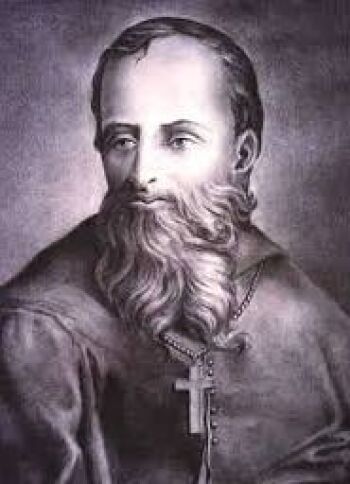
Religion and Branch: Christianity (Catholicism)
Title: Bishop, Missionary
Pierre Lambert de la Motte was a French bishop and missionary who played a foundational role in establishing Roman Catholic missions in Southeast Asia.
Together with François Pallu and Ignace Cotolendi, he established the Paris Foreign Missions Society in 1658. This society was intended to train priests for missionary work, primarily in Asia. It has been instrumental in promoting Catholicism in many parts of Asia. Even today, the Paris Foreign Missions Society remains active in evangelization and charitable activities in various Asian countries.
Motte left France for the mission fields in Southeast Asia. He was notably active in Siam (modern-day Thailand) and other regions. His works paved the way for the establishment and expansion of Catholicism in these areas.
Motte was appointed as the vicar apostolic of the new Vicariate Apostolic of Cochin, which covered parts of present-day Vietnam. This appointment gave him episcopal jurisdiction over territories in Southeast Asia.
Motte's primary contributions were in the realm of overseas missions, his activities were rooted in the religious fervor and missionary zeal of 17th-century France. His work exemplifies the Catholic Counter-Reformation's commitment to expanding the faith outside of Europe.
François Fénelon (1651-1715)
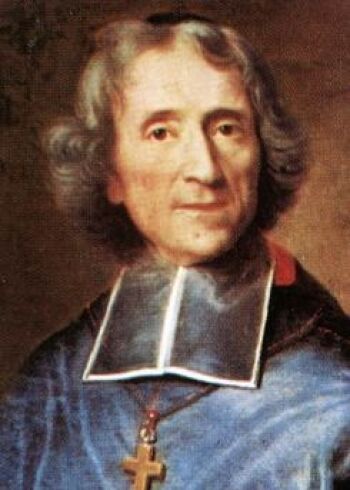
Religion and Branch: Christianity (Catholicism)
Title: Archbishop of Cambrai, Theologian, Writer
François Fénelon was a French Roman Catholic archbishop, theologian, poet, and writer.
Fénelon is best known for his spiritual writings, particularly Explanation of the Maxims of the Saints on the Interior Life. In this work, he discussed the idea of pure love of God for its own sake, separate from any hope of reward or fear of punishment.
This book led to a significant theological controversy as it was seen to align with the views of the Quietist movement, particularly those of Madame Guyon. Quietism emphasizes passive contemplation and the complete annihilation of the will in the presence of the Divine. The Catholic Church, and notably his former friend and theological adversary, Bossuet, charged that Fénelon's and Guyon's teachings were heretical. The controversy culminated in Pope Innocent XII's condemnation of Fénelon's Maxims of the Saints in 1699.
Fénelon served as the archbishop of Cambrai from 1695 until his death. He was recognized for his pastoral zeal and commitment to the spiritual and moral betterment of his flock.
Despite the controversies during his lifetime, Fénelon's influence persisted posthumously. His writings, especially those on spirituality and education, continued to be read and admired both in France and abroad.
Fénelon stands out in French religious history for his spiritual writings, his role in the Quietism controversy, and his progressive views on education. He remains a figure of enduring interest in the history of Christian spirituality.
Marcellin Champagnat (1789-1840)
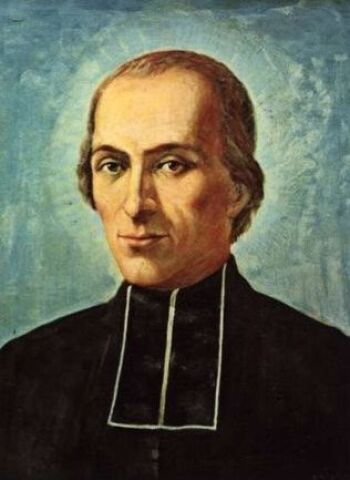
Religion and Branch: Christianity (Catholicism)
Title: Saint, Priest, Founder of Marist Brothers
Marcellin Champagnat was a Catholic priest and the founder of the Marist Brothers, a religious congregation dedicated to the education of young people, especially those most neglected. His work is situated in the religious context of 19th-century France, which experienced a revival of Catholicism after the French Revolution and the subsequent Napoleonic era.
Born in the village of Marlhes, France, Champagnat was deeply influenced by his own experiences as a student, understanding the importance of teachers who were both knowledgeable and devout. Ordained as a priest in 1816, he felt a strong calling to address the lack of education, particularly religious education, in the rural areas of France.
In 1817, Champagnat founded the Little Brothers of Mary, or Marist Brothers, in La Valla-en-Gier. This was an extension of the larger Marist movement, which sought to establish a new religious family in the Church, consisting of men and women religious, as well as laypeople, all working together under the banner of Mary.
Under Champagnat's guidance, the Marist Brothers focused on providing holistic education, emphasizing both academic and spiritual formation. They established schools in rural areas, bringing education to those who had limited access to it. By the time of his death in 1840, the congregation had grown significantly, and the Marist Brothers had become known for their educational work. Today, the Marist Brothers are present worldwide.
Champagnat played a crucial role in the 19th-century religious landscape of France by addressing the educational needs of the rural poor and emphasizing the importance of religious instruction. He was beatified by Pope Pius XII in 1955 and canonized a saint by Pope John Paul II in 1999. He is venerated for his deep piety, love for Mary, and commitment to education.
Copyright © 1993—2024 World Trade Press. All rights reserved.

 France
France